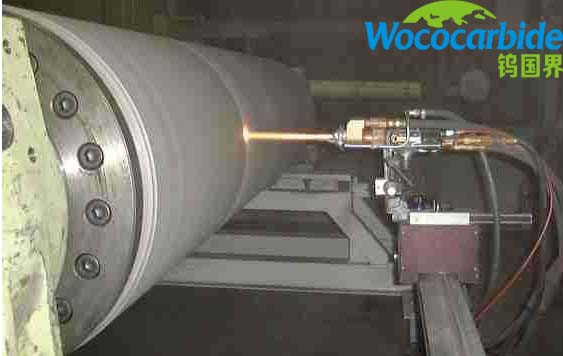

The 16 fermentation tanks in the low-temperature fermentation workshop of a winery were welded with ordinary stainless steel. After use, it was found that there was pitting corrosion on the inner wall of the fermentation tank. More seriously, the iron ions in the wine exceeded the standard due to corrosion, which affected the product quality. It can only be used to store medium and low-grade wines. In order to solve the problem of anti-corrosion and iron ion exudation on the inner wall, Wuhan Institute of Materials Protection cooperated with the factory to use on-site flame spraying plastic protective coating to protect the wine tank, and achieved good results. The spraying process is as follows:

1. Requirements for coating
The canned wine capacity of the wine that needs to be sprayed and protected is 22t, the tank diameter is 2.4m, the tank height is 5.4m, and the wall thickness is 3mm. Before filling the wine, it must be disinfected and cleaned with acid solution, and then treated with lye solution (NaOH). Portuguese wine is acidic. When the wine is output and input into the tank, the tank wall is subject to vacuum suction (after the wine has been pumped) and the scouring of the wine. During use, a microbial tartaric acid in wine will continuously deposit on the surface of the inner wall, forming a thick and hard scale-like deposition layer, which needs to be removed frequently. Therefore, the inner wall coating not only requires materials that are non-toxic, tasteless, and does not affect the quality of wine In addition, it should also have a certain acid resistance and alkali resistance. The coating should be well combined with the tank wall and should not fall off during use. The coating should preferably be non-stick to the tartaric acid so that the tartaric acid deposit can be easily removed and the surface smooth.
2. Selection of coating material
Through the immersion test of flame sprayed samples in wine stock solution and ethanol, it is known that white polyethylene and epoxy powder are the best spraying materials. The polyethylene powder material is white low pressure (high density) polyethylene powder with a particle size of 120~160 mesh. Epoxy powder is a spray powder specially produced according to requirements, with a particle size of 120~180 mesh. Both powders have good fluidity and can be sprayed with a powder hopper type spray gun.
3. Sandblasting pretreatment
First remove the sediment on the inner wall of the tank, and then use the pressure sandblasting equipment to blast the sand with corundum sand. The sandblasting construction is carried out in the order of bottom-cylindrical surface-top. After sandblasting, check carefully, clean up to prevent leakage and remove floating dust.
4. Surface preheating
The purpose of preheating the surface of the substrate is to remove the surface moisture, so that the molten plastic can completely infiltrate the surface of the substrate, so as to obtain the best combination with the substrate and the long-term performance of the coating. The matrix is usually preheated to near the melting point of the powder material. Because the wall of the wine tank is very thin (3mm), the wine tank is made of stainless steel, and the surface is not easy to oxidize. Therefore, when spraying polyethylene, the preheating temperature can be slightly higher than the melting point of the powder material. During the spraying process, the substrate should be preheated continuously, one piece should be preheated, and one piece should be cured by spraying. However, care should be taken not to make the temperature of the substrate too high, so as not to cause the coating to blister and create pinholes. When spraying epoxy powder, it is only necessary to preheat for a few minutes before spraying, so that the surface temperature of the substrate reaches 60~80 °C. Later, the heat of the spray gun during the spraying process is enough to make the surface temperature of the substrate in the spraying area higher than 60 °C.
5. Spray
The flame spray construction of wine cans is carried out in a top-to-bottom order, that is, top→cylinder→bottom. After the surface of the substrate is preheated to the required temperature, the powder can be sprayed. When spraying, the moving speed of the spray gun should be kept uniform and consistent, and the surface state of the coating should be paid attention to at all times, so that the spray coating will appear similar to the mirror reflection phenomenon that occurs when the flame is sprayed and melted. Smooth state, so as to achieve the best bond between the coating and the substrate. Otherwise, the substrate should be reheated and the spray speed reduced.
The spraying parameters of flame spraying polyethylene are: oxygen pressure 1~2Pa, acetylene pressure 0.5~0.8Pa, air pressure 1Pa, spraying distance 150~250mm. The parameters when spraying epoxy are: air pressure 4Pa, and the rest are the same as spraying polyethylene.
6. Heat curing
When spraying epoxy powder, as long as attention is paid to the use of spraying heat, the spray gun moves evenly, and the sprayed coating can basically be in a completely melted and leveled state, and it is well infiltrated with the surface of the substrate. Generally, it is not necessary to heat and cure after spraying. However, for polyethylene coating, because polyethylene is not easy to melt, and the leveling of the coating is not as good as that of epoxy coating, it needs to be reheated with a spray gun after spraying, or stop powder feeding after spraying to make the coating completely melt and flow. Continue spraying after leveling. When heating, care should be taken to prevent the coating from overheating and yellowing.
Hot information

